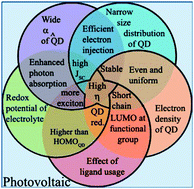On the missing links in quantum dot solar cells: a DFT study on fluorophore oxidation and reduction processes in sensitized solar cells†
Abstract
The possibility of achieving many electrons per absorbed photon of sufficient energy by quantum dots (QDs) drives the motivation to build high performance quantum dot solar cells (QDSCs). Although performance of dye-sensitized solar cells (DSCs), with similar device configuration as that of QDSCs, has significantly improved in the last two decades QDSCs are yet to demonstrate impressive device performances despite the remarkable features of QDs as light harvesters. We investigated the fundamental differences in the optical properties of QDs and dyes using DFT calculations to get insights on the inferior performance of QDSCs. The CdSe QDs and the ruthenium bipyridyl dicarboxylic acid dye (N3) were used as typical examples in this study. Based on a generalized equation of state correlating material properties and photoconversion efficiency, we calculated ground and excited state properties of these absorbers at the B3LYP/lanl2dz level of DFT and analyzed them on the basis of the device performance. Five missing links have been identified in the study which provides numerous insights into building high efficiency QDSCs. They are (i) fundamental differences in the emitting states of the QDs in the strong and weak confinement regimes were observed, which explained successfully the performance differences; (ii) the crucial role of bifunctional ligands that bind the QDs and the photo-electrode was identified; in most cases use of bifunctional ligands does not lead to a QD enabled widening of the absorption of the photo-electrode; (iii) wide QDs size distribution further hinders efficient electron injections; (iv) wide absorption cross-section of QDs favours photon harvesting; and (v) the role of redox potential of the electrolyte in the QD reduction process.


 Please wait while we load your content...
Please wait while we load your content...